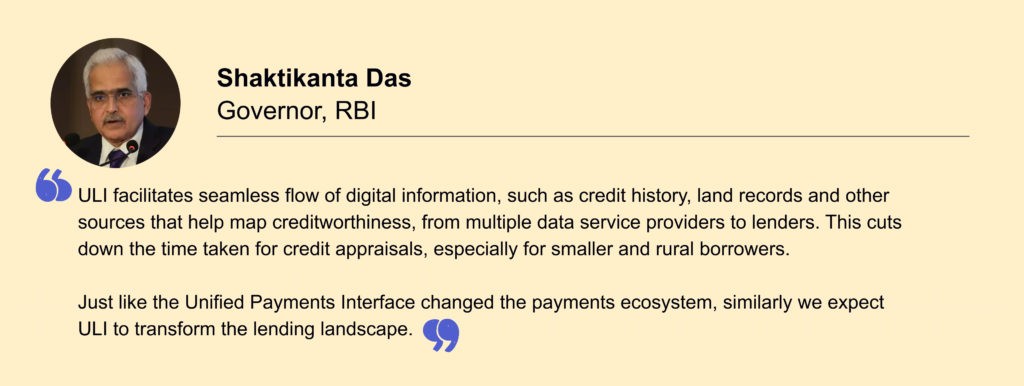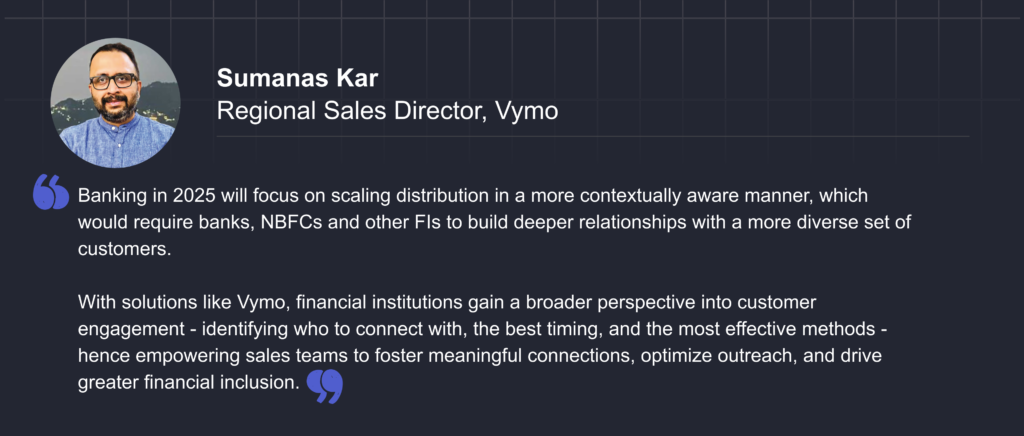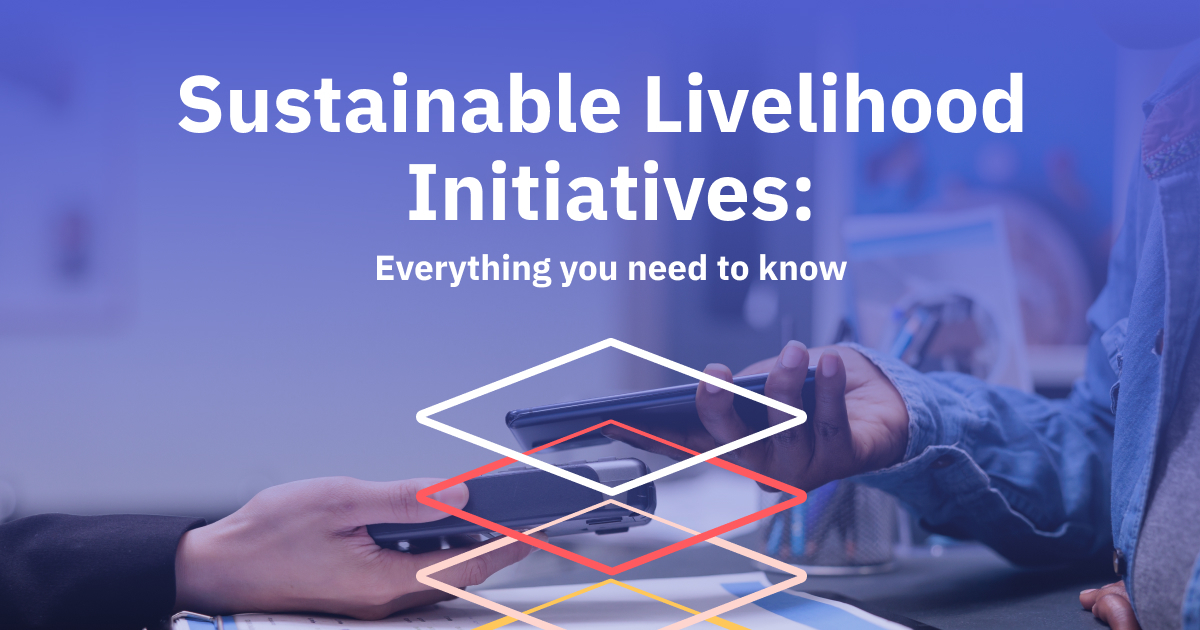As we delve into 2025, the banking industry is already feeling the effects of technological advancements like generative AI, the digital banking revolution and government policies aimed at increasing financial product penetration worldwide. Most trends and shifts in the industry are driven by customer needs and demands. Here are a few major trends that will shape banking and financial sales over this year :

COMPLIANCE – Evolving Regulatory Landscape Aimed At Increasing Banking Penetration
Most regulatory changes globally in 2025 are aimed at enhancing banking penetration among individuals and organizations in the underbanked sector. These changes are expected to create ripple effects, significantly influencing banking operations for financial institutions.
This dynamic environment will require banks to remain agile, upgrade their technology, and recalibrate their strategies to align with new requirements while optimizing capital utilization.
Unified Lending Interface (ULI)
In India, the introduction of the Unified Lending Interface (ULI) aims to improve creditworthiness assessments for banks and NBFCs. The ULI addresses a critical gap in lending by integrating essential data from various sources—including government authorities, fintech companies, and credit bureaus—into a single platform through standardized APIs.
This integration allows lenders to access both standard and alternative data sources—such as credit scores and financial histories—more efficiently, reducing credit approval times from days to mere hours.
With a stronger underwriting process, financial institutions can manage more risks and extend loans to a broader range of borrowers, including MSMEs (Micro, Small, and Medium Enterprises). For sales teams, this translates to a greater emphasis on distribution management and achieving higher disbursals per seller.
Increased disbursals per seller can be realized by either engaging with more customers or enhancing the effectiveness of each customer interaction, thereby improving banking penetration. This initiative marks a significant step toward creating a more inclusive financial landscape. Click here to learn more about this initiative.

Most regulatory changes globally in the coming years are initiatives aimed at increasing banking penetration among underbanked and underserved sectors. Banks must focus on technology that can strengthen their distribution and sales, to be able to optimize processes, bring in efficiencies and grow further in underserved markets.
Stronger Distribution Capabilities With Vymo
Vymo’s distribution management system empowers financial institutions by providing sellers with a mobile-based sales enablement platform to engage with leads more effectively. Vymo automatically captures both on-field and digital engagement activities of each seller and provides contextual next-best-action suggestions that helps them drive successful sales conversations. This in turn improves the efficiency of sales teams as they are able to then capture more leads and in the same given time. More about Vymo’s mobility solution has been explored here.

CONSUMER – Greater Customer Lifetime Value Driven by an Increased Focus on Non-Interest Income Streams
As net interest income faces pressure due to declining interest rates—projected at around 2.03% as per Deloitte in 2025—banks will increasingly prioritize non-interest income streams. Historically, non-interest income has averaged about 35% of total income for U.S. banks over the past decade; however, growth has been modest.
To combat stagnation in this area, banks must innovate their revenue strategies. Potential avenues include enhancing fee structures through embedded financial services, bundling offerings, and employing tiered pricing based on customer segmentation.
To effectively curate product offerings for customers and maximize customer value, sellers need visibility into customer segmentation and detailed information on each lead. Tech platforms that enable 360-degree information on leads and customers can massively help sellers identify potential cross-sell and upsell opportunities.
Improved Customer Visibility With Vymo
Vymo allocates leads to sellers using a sophisticated machine learning engine that provides each seller with a detailed view into their associated leads and customers. With deep-dive visibility on the engagement history, customer milestones, recommended offers, upcoming renewals, and more, sellers are well-equipped to have comprehensive sales conversations and understand their customers’ end-to-end needs.
Vymo further categorizes leads based on attributes and conversion propensity, designating them as hot, warm, or cold, which enables sellers to prioritize their approach when engaging with each customer. More on Vymo’s dynamic lead scoring has been explored here.
COMPETENCY – Workforce Requirements Based on Technological Advancements
With the evolving landscape, banks must leverage data analytics in 2025, for deep understanding of customer needs, and better personalization efforts. This involves developing a customer-centric mindset in financial institutions and tailor mechanisms and frameworks to decide which product and service resonates with a specific customer segment.
According to CXO Today, fintech continues to rise and financial organizations are now seeking talent proficient in data analytics and adaptable to new technologies.
Consequently, banks must rethink their recruitment strategies to attract individuals who can effectively navigate this evolving landscape and incorporate technology and AI into their daily sales operations. Read more about AI in retail lending here.
Sales Intelligence With Vymo
Vymo utilizes intelligent AI and machine learning models to enable even less tech-savvy salespeople to sell better. With Vymo’s product recommendation engine, each seller knows which product or offer should be pitched to which customer.
Additionally, the AI Assist feature helps sellers address any queries related to products or processes. Vymo’s smart tiering dynamically segregates channel partners based on attributes and performance metrics while providing managers with contextual suggestions for engaging with their associated sellers more effectively.
Conclusion
In conclusion, the banking industry in 2025 will be characterized by a complex interplay of regulatory changes (Compliance), curated customer needs (Consumer), and an increased expectation from individual sellers (Competency).
By proactively addressing these trends and adapting their strategies accordingly, banks can position themselves for sustainable growth amid an evolving landscape. The ability to navigate these dynamics will be crucial for banking executives aiming to thrive in the coming years.



